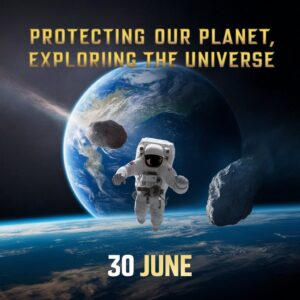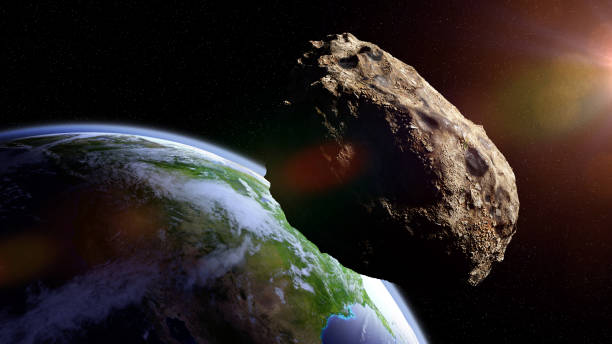Asteroid Day – Elevate Awareness, Protect Our Planet

Asteroid day is celebrated every year on June 30. It is known about the importance of following the stars and not affecting the earth. Any dinosaurs left on Earth may not like us, but on June 30 we celebrate International Asteroid Day. So let’s know about the Asteroid Day.
Why June 30?: On this day 30 June is the anniversary of the Tunguska incident in 1908, when a meteor exploded in Siberia, and destroying a large amount of the forest.
Credit: We should note that the Asteroid Day was founded in 2014 by Astrophysicist Dr. Brian May, also known as Brian May.
Recognition by the United Nations: Recognizing the importance of asteroids in today’s world, the United Nations designated June 30, 2016, as World Asteroid Day. The UN emphasized the significance of this day for global awareness and education. On this day, activities are held to help people learn more about asteroids and how to protect Earth from potential impacts.
Events: A variety of events will take place throughout the day, including educational programs, discussions with scientists, and community events to learn more about the stars and protect the planet.
History of Asteroid Day

Asteroid Day (also known as International Asteroid Day) is a global event, held annually on the anniversary of the Siberian Tunguska Event that took place in 1908 – when an asteroid entered Earth’s atmosphere and subsequently exploded.
June 30 is mainly to focus on research by scientists, progress in technology and international collaboration towards the risks posed by asteroids. This Day is a key event in worldwide schemes to protectEarth from asteroid impacts,to educate the public and both national and local governments about these issues.
Dr. Brian May of Queen, astronaut Rusty Schweickart, Danica Remy, and filmmaker Greg Richters created this Day in 2014. Inspired by Richters’ film 51 Degrees North, they wanted to raise awareness of the dangers of asteroids and show what could happen if an asteroid hit London.
Siberia
Siberia, is the vast area of Russia and northern Kazakhstan that includes all of North Asia. Siberia stretches from the Ural Mountains in the west to the Pacific Ocean in the east, and from the Arctic Ocean in the south to the highlands of north-central Kazakhstan and the border of Mongolia and China.

Siberia, derived from the Tatar word for “land of sleep”, is famous for its long and severe snowless winters: the lowest temperature recorded in the region is −90 °F (−68 °C). The air grew heavier as it headed east, and the rain fell. The main vegetation zone runs from east-west across the region – tundra in the north; Most of Siberia is a swamp forest or taiga; and in the desert forests and deserts of southwestern Siberia and in the southern intertidal basins.
Visit More :- htSiberiatps://en.wikipedia.org/wiki/
International Asteroid day
The event falls on June 30, 2015, in anticipation of the eleventh anniversary from all over Siberian Tunguska Event prepared by which an asteoid that hit Earth planet.
The event will also feature the launch of their “100x Promo”, where they find 100 times more asteroids than Earth every year! And that is a way better one liners and you can find plenty of Scientists to support this in their quotes.
Asteroid Day was officially designated as a global event by the United Nations in 2017; it is held on June 30th. While on the one side, it can help in adopting a greater degree of caution and global cooperation among countries to identify an emerging cosmos threat but at the same time offers insights about how such a dread scenario could be avoided.

Education and Promotion
Scientist and earth protective organizations lead the lectures of discussions, and academic event in this day. Asteroid day goals to teach human beings approximately asteroids and the dangers they pose. It includes lectures, seminars, and a media marketing campaign to unfold the phrase approximately the importance of finding the monitoring asteroids. The occasion offers a laugh and academic activities to faculties and groups, supporting every person study area. This day invites every person to shield the Earth from Aestroids collisions by raising awareness and understanding and helping medical reasearch and coperations around the world
Important Meteor
Billions of billions of years have been transformed by space rocks! Here are the 10 biggest accidents, based on scientific evidence, Important meteor events that have occurred on Earth are as follows:
Chicxulub Crater
Chicxulub Crater in Mexico is linked to an asteroid impact that wiped out the dinosaurs 66 million years ago. This event shows the catastrophic potential of an asteroid collision with Earth.
Vredefort Crater
The Vredefort Crater, also known as Vredefort Dome, formed 2 billion years ago and spans 118 kilometres (190 mi) in radius, making it Earth’s largest impact crater. UNESCO declared the crater a World Heritage Site in 2005
Sudbury Crater
The Sudbury Basin is known as one of the largest impact structures on Earth, measuring approximately 81 miles (130 km) in diameter. 1.8 billion years ago, it is one of the oldest known impact structures in the world.
Manikouagan Crater
Manikouagan Crater in Quebec, Canada was formed approximately 214 million years ago and is a major site for studying impact events.
Popigai Crater
Popigai Crater, located in Siberia, Russia, is one of the largest craters known for its diamond-rich deposits, created by an asteroid impact about 35 million years ago.
Chesapeake Bay Crater
The Chesapeake Bay Crater in the United States was formed by an asteroid impact about 35 million years ago and has had a significant impact on the geological and hydrological history of the area.
Black Crater
Kara Crater in Russia formed about 70 million years ago, is another important impact site that shows the widespread impact of asteroid impacts on the Earth’s surface.
Woodleigh Crater
Woodley Crater in Western Australia formed about 364 million years ago, is a little-known but important impact site that provides insight into the frequency and impact of large impacts.
Acraman Crater
Acraman Crater in South Australia formed about 580 million years ago, is associated with significant geological and biological changes on Earth, reflecting the profound effects of asteroid impacts.
Morokweng Crater
Morokweng Crater, located in South Africa, was formed by an asteroid impact about 145 million years ago, contributing to our understanding of Earth’s impact history.

Future Plans
Asteroids and a Safe Future :
Scientists are actively developing new methods to discover and monitor asteroids, aiming to safeguard the world from potential threats. This involves advancements in telescopes, computational models, and workstations to enhance preparedness against incoming celestial objects. A team of astronomers is meticulously tracking objects as large as Earth and projecting their trajectories over the next 1,000 years to assess any potential risks to our Solar System’s safety.
Conclusion:
Although there are currently no asteroids known to pose a threat to Luxembourg, the possibility of future risks highlights the importance of international cooperation in monitoring and addressing them. As a member of the United Nations, Luxembourg has a responsibility to support global efforts to protect the Earth. By playing its role in the international community, Luxembourg may contribute to advancements in asteroid detection and deflection through collaborative efforts.
Check Out My Article based on another topic :- The Blue Parrot Cafe Delhi

